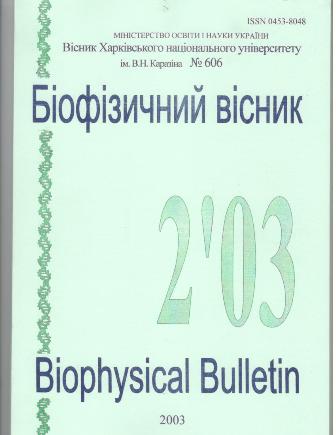Флуоресценция и динамика структурного окружения флуорофора TRP125 в цитокине EMAP II
Анотація
Цитокин EMAP II - мультифункциональный белок, обладающий как цитокиновой, так и РНК-связывающией активностями. Методом флуоресцентной спектроскопии изучена внутримолекулярная динамика цитокина ЕМАР II в растворе. Спектр триптофановой флуоресценции цитокина ЕМАР II обусловлен эмиссией остатка Trp125 в белке. На основании данных флуоресцентной спектроскопии и компьютерного моделирования охарактеризовано микроокружение остатка триптофана и степень доступности поверхности Trp125 молекулам растворителя, которая составляет около 10 %. Быстрая конформационная подвижность в цитокине EMAP II обнаружена с помощью тушения флуоресценции флуорофора Trp125 нейтральным тушителем акриламидом вследствие флуктуаций структуры белка в наносекундном временном интервале.
Завантаження
Посилання
Kao J, Houck K, Fan Y, Haehnel I, Libutti SK, Kayton ML, et al. Characterization of a novel tumor-derived cytokine Endothelia-monocyte activating polypeptide II. J. Biol. Chem. 1994;269:25106019.
Schwarz MA, Kandel J, Brett J, Li J, Hayward J, Schwarz RE, et al. Endothelia-monocyte activating polypeptide II, a novel antitumor cytokine that suppresses primary and metastatic tumor growth and induses apoptosis in growing endothelial cell. J. Exp. Med. 1999;190(3):4066-9.
Marvin MR, Libutti SK, Kayton M, Kao J, Hayward J, Grikscheit T, et al. A novel tumor-derived mediator that sensitizes cytokine-resistant to tumors to tumors necrosis factor. J. Surg. Res. 1996;24:248-55.
Berger AC, Tang G, Alexander HR, Libutti SK. Endothelia-monocyte activating polypeptide II induces endothelial cell apoptosis and may inhibit tumor angiogenesis. Microvasc. Res. 2000;60:70-80.
Shalak V, Kaminska M, Mitnaht-Kraus R, Vandenabeele P, Clauss M, Mirande M. The EMAP II cytokine is released from the mammalian multysynthetase complex after cleavage of its p43/proEMAP II component. J. Biolog. Chem. 2001;276(26):23769-76.
Mirande M. Aminoacyl-tRNA synthetase family from prokaryotes and eukaryotes: structural domains and their implications. Prog. Nucleic Acid Res. Mol. Biol. 1991;40:95-142.
Levanetc OV, Naidenov VG, Odynetc KA, Vudmaska MI, Matcuka GKh, Korneliuk AI. Gomologiia S-kontcevogo nekataliticheskogo domena tirozil-tRNK sintetazy mlekapitaiushchikh s tcitokinom EMAP II i nekataliticheskimi domenami metionil- i fenilalanil-tRNK sintetaz. Biopolimery i kletka. 1997;13(6):474-478. (in Russian)
Kornelyuk A, Maarten P, Dubrovsky A, Murray J. Cytokine activity of non-catalytic EMAP II-like domain of mammalian tyrosyl-tRNA synthetase. Biopolimery I kleitka. 1999;15(2):168-72.
Chihade V, Schimmel P. Assembly of a catalytic unit for RNA microhelix aminoacylation using nonspecific RNA binding domains. Proc. Natl. Acad. Sci. USA. 1999;96:12316-21.
Wang CC, Schimmel P. Species barrier to RNA recognition overcome with nonspecific RNA binding domains. J. Biol. Chem. 1999;274:16508-12.
Lakkowicz JR. Principles of Fluorescent Spectroscopy. New York: Plenum Press; 1999.
Ladokhin AS. Fluorescence spectroscopy in peptide and protein analysis. Encyclopedia of Analytical Chemistry. Chichester: John Wiley & Sons Ltd; 2000.
Dubrovskii AL, Braun Dzh, Korneliuk AI, Miurrei K, Matcuka GKh. Bakterialnaia ekspressiia polnorazmernykh i usechennykh form tcitokina EMAR II i tcitokinopodobnogo domena tirozil-tRNK sintetazy mlekoptaiushchikh. Biopolimery i kletka. 2000;16(3):229-35. (in Russian)
Ehrenberg M, Cronvall E, Rigler R. Fluorescence of proteins interacting with nucleic acids: Correction for light absorbtion. FEBS Lett. 1971;18(2):199-203.
Renault L, Kerjan P, Pasqualato S, Menetrey J, Robinson JC, Kawaguchi S, et al. Structure of the EMAP II domain of human aminoacil-tRNA synthetase complex reveals evolutionary dimer mimicry. EMBO J. 2001;20(3):570-8.
Kim Y, Shin J, Li R, Cheong C, Kim K, Kim S. A novel anti-tumor cytokine contains a RNA-binding motif present in aminoacyl-tRNA synthetases. J. Biol. Chem. 2000;275:27062-8.
Burshtein EA. Sobstvennaia liuminestcentciia belka. Priroda i primenenie. Itogi nauki i tekhniki. Biofizika. 1977;7:189-95.
Burstein EA, Vedenkina NS, Ivkova MN. Fluorescence and the location of tryptophan residues in protein molecules. Photochem. Photobiol. 1973;18(2):263-79.
Kantor Ch, Shimmel P. Biofizicheskaia khimiia. Moskva: Mir; 1984. 336p.
Chen Y, Barkley MD. Toward understanding tryptophan fluorescence in proteins. Biochemistry. 1998;37(28):9976-82.
Автори, які публікуються у цьому журналі, погоджуються з наступними умовами:
- Автори залишають за собою право на авторство своєї роботи та передають журналу право першої публікації цієї роботи на умовах ліцензії Creative Commons Attribution License, котра дозволяє іншим особам вільно розповсюджувати опубліковану роботу з обов'язковим посиланням на авторів оригінальної роботи та першу публікацію роботи у цьому журналі.
- Автори мають право укладати самостійні додаткові угоди щодо неексклюзивного розповсюдження роботи у тому вигляді, в якому вона була опублікована цим журналом (наприклад, розміщувати роботу в електронному сховищі установи або публікувати у складі монографії), за умови збереження посилання на першу публікацію роботи у цьому журналі.
- Політика журналу дозволяє і заохочує розміщення авторами в мережі Інтернет (наприклад, у сховищах установ або на особистих веб-сайтах) рукопису роботи, як до подання цього рукопису до редакції, так і під час його редакційного опрацювання, оскільки це сприяє виникненню продуктивної наукової дискусії та позитивно позначається на оперативності та динаміці цитування опублікованої роботи (див. The Effect of Open Access).





